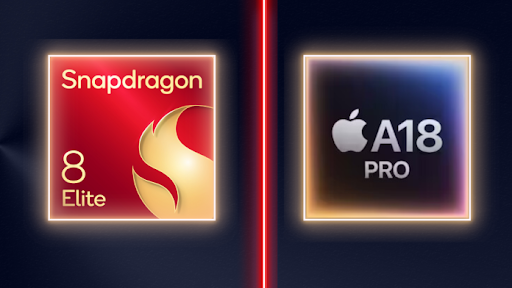In the ever-evolving landscape of mobile technology, two processors have recently taken center stage: Qualcomm's Snapdragon 8 Elite and Apple's A18 Pro. Both are engineered on TSMC's 3nm (N3E) process, promising significant advancements in performance and efficiency. This article delves into a comprehensive comparison of these two flagship chipsets, examining their architectures, benchmark performances, and unique features.
CPU Architecture and Performance
The Snapdragon 8 Elite introduces Qualcomm's second-generation Oryon CPU, featuring an octa-core configuration with two prime cores clocked at 4.32GHz and six performance cores at 3.53GHz. This setup is designed to handle intensive tasks with ease, offering robust multi-core performance. In contrast, Apple's A18 Pro employs a hexa-core CPU comprising two high-performance cores at 4.05GHz and four efficiency cores at 2.42GHz, focusing on a balance between power and energy efficiency.
Benchmark tests reveal nuanced differences: the A18 Pro excels in single-core tasks, scoring approximately 3,358 points, while the Snapdragon 8 Elite leads in multi-core performance with scores around 9,271 points. These results suggest that while Apple's chip offers superior performance for individual tasks, Qualcomm's processor is better suited for multitasking and parallel processing.
Graphics Processing Unit (GPU) and Gaming
Graphics performance is a critical aspect of modern processors. The Snapdragon 8 Elite's Adreno 830 GPU introduces a "sliced" architecture, delivering a 40% performance boost over its predecessors and supporting advanced features like Unreal Engine 5.3 Nanite. This makes it particularly advantageous for high-fidelity gaming experiences. Meanwhile, the A18 Pro's 6-core GPU, enhanced by hardware-accelerated ray tracing, offers a 20% performance increase over the previous generation, catering to both gamers and creative professionals.
Artificial Intelligence (AI) Capabilities
AI integration has become pivotal in enhancing user experiences. The Snapdragon 8 Elite features an upgraded Hexagon AI Engine capable of handling complex AI tasks, including real-time language translation and image recognition. Apple's A18 Pro, equipped with a 16-core Neural Engine performing up to 35 trillion operations per second, is optimized for on-device AI processes, ensuring swift and efficient machine learning applications.
Power Efficiency and Thermal Management
Both processors are built on TSMC's 3nm process, enhancing power efficiency. The Snapdragon 8 Elite is designed to manage power consumption effectively, even under heavy workloads, thanks to its architectural optimizations. Similarly, the A18 Pro emphasizes energy efficiency, particularly during high-performance tasks, contributing to prolonged battery life and reduced heat generation.
Connectivity and Additional Features
Connectivity options are robust in both chipsets. The Snapdragon 8 Elite integrates the Snapdragon X80 5G modem, offering peak download speeds up to 10 Gbps and support for Wi-Fi 7 and Bluetooth 6.0. The A18 Pro, utilizing the Snapdragon X75 5G modem, also provides 10 Gbps download speeds, with support for Wi-Fi 7 and Bluetooth 5.3. Both processors include Ultra Wideband (UWB) technology, enhancing spatial awareness applications.
Conclusion
Choosing between the Snapdragon 8 Elite and the A18 Pro depends largely on user priorities. The Snapdragon 8 Elite offers superior multi-core performance and advanced gaming capabilities, making it ideal for users who prioritize multitasking and high-end gaming. Conversely, the A18 Pro excels in single-core tasks and seamless integration within Apple's ecosystem, appealing to users who value efficiency and a cohesive user experience. Both processors represent significant strides in mobile computing, setting new benchmarks for future developments.


